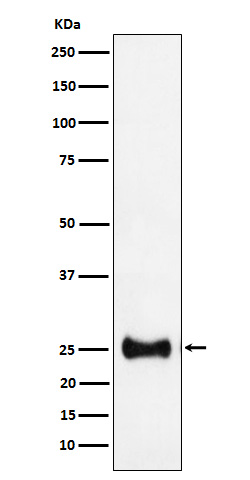Anti-Adenylate kinase 4 Rabbit Monoclonal Antibody
- SPECIFICATION
- CITATIONS
- PROTOCOLS
- BACKGROUND

Application
| WB, IHC, IF, ICC |
|---|---|
| Primary Accession | P27144 |
| Host | Rabbit |
| Isotype | IgG |
| Reactivity | Human |
| Clonality | Monoclonal |
| Format | Liquid |
| Description | Anti-Adenylate kinase 4 Rabbit Monoclonal Antibody . Tested in WB, IHC, ICC/IF applications. This antibody reacts with Human. |
| Gene ID | 205 |
|---|---|
| Other Names | Adenylate kinase 4, mitochondrial {ECO:0000255|HAMAP-Rule:MF_03170}, AK 4 {ECO:0000255|HAMAP-Rule:MF_03170}, 2.7.4.10 {ECO:0000255|HAMAP-Rule:MF_03170, ECO:0000269|PubMed:19766732, ECO:0000269|PubMed:23416111}, 2.7.4.6 {ECO:0000255|HAMAP-Rule:MF_03170, ECO:0000269|PubMed:19766732, ECO:0000269|PubMed:23416111}, Adenylate kinase 3-like {ECO:0000255|HAMAP-Rule:MF_03170}, GTP:AMP phosphotransferase AK4 {ECO:0000255|HAMAP-Rule:MF_03170}, AK4 {ECO:0000255|HAMAP-Rule:MF_03170} |
| Calculated MW | 25 kDa |
| Application Details | WB 1:500-1:2000 IHC 1:50-1:200 ICC/IF 1:50-1:200 |
| Contents | Rabbit IgG in phosphate buffered saline, pH 7.4, 150mM NaCl, 0.02% sodium azide and 50% glycerol, 0.4-0.5mg/ml BSA. |
| Clone Names | Clone: 27A39 |
| Immunogen | A synthesized peptide derived from human Adenylate kinase 4 |
| Purification | Affinity-chromatography |
| Storage | Store at -20°C for one year. For short term storage and frequent use, store at 4°C for up to one month. Avoid repeated freeze-thaw cycles. |
| Name | AK4 (HGNC:363) |
|---|---|
| Function | Broad-specificity mitochondrial nucleoside phosphate kinase involved in cellular nucleotide homeostasis by catalyzing nucleoside- phosphate interconversions (PubMed:19073142, PubMed:19766732, PubMed:23416111, PubMed:24767988). Similar to other adenylate kinases, preferentially catalyzes the phosphorylation of the nucleoside monophosphate AMP with ATP as phosphate donor to produce ADP (PubMed:19766732). Phosphorylates only AMP when using GTP as phosphate donor (PubMed:19766732). In vitro, can also catalyze the phosphorylation of CMP, dAMP and dCMP and use GTP as an alternate phosphate donor (PubMed:19766732, PubMed:23416111). Moreover, exhibits a diphosphate kinase activity, producing ATP, CTP, GTP, UTP, TTP, dATP, dCTP and dGTP from the corresponding diphosphate substrates with either ATP or GTP as phosphate donors (PubMed:23416111). Plays a role in controlling cellular ATP levels by regulating phosphorylation and activation of the energy sensor protein kinase AMPK (PubMed:24767988, PubMed:26980435). Plays a protective role in the cellular response to oxidative stress (PubMed:19130895, PubMed:23474458, PubMed:26980435). |
| Cellular Location | Mitochondrion matrix {ECO:0000255|HAMAP- Rule:MF_03170, ECO:0000269|PubMed:11485571, ECO:0000269|PubMed:19766732, ECO:0000269|PubMed:26980435} |
| Tissue Location | Highly expressed in kidney, moderately expressed in heart and liver and weakly expressed in brain |

Thousands of laboratories across the world have published research that depended on the performance of antibodies from Abcepta to advance their research. Check out links to articles that cite our products in major peer-reviewed journals, organized by research category.
info@abcepta.com, and receive a free "I Love Antibodies" mug.
Provided below are standard protocols that you may find useful for product applications.
If you have used an Abcepta product and would like to share how it has performed, please click on the "Submit Review" button and provide the requested information. Our staff will examine and post your review and contact you if needed.
If you have any additional inquiries please email technical services at tech@abcepta.com.













 Foundational characteristics of cancer include proliferation, angiogenesis, migration, evasion of apoptosis, and cellular immortality. Find key markers for these cellular processes and antibodies to detect them.
Foundational characteristics of cancer include proliferation, angiogenesis, migration, evasion of apoptosis, and cellular immortality. Find key markers for these cellular processes and antibodies to detect them. The SUMOplot™ Analysis Program predicts and scores sumoylation sites in your protein. SUMOylation is a post-translational modification involved in various cellular processes, such as nuclear-cytosolic transport, transcriptional regulation, apoptosis, protein stability, response to stress, and progression through the cell cycle.
The SUMOplot™ Analysis Program predicts and scores sumoylation sites in your protein. SUMOylation is a post-translational modification involved in various cellular processes, such as nuclear-cytosolic transport, transcriptional regulation, apoptosis, protein stability, response to stress, and progression through the cell cycle. The Autophagy Receptor Motif Plotter predicts and scores autophagy receptor binding sites in your protein. Identifying proteins connected to this pathway is critical to understanding the role of autophagy in physiological as well as pathological processes such as development, differentiation, neurodegenerative diseases, stress, infection, and cancer.
The Autophagy Receptor Motif Plotter predicts and scores autophagy receptor binding sites in your protein. Identifying proteins connected to this pathway is critical to understanding the role of autophagy in physiological as well as pathological processes such as development, differentiation, neurodegenerative diseases, stress, infection, and cancer.


